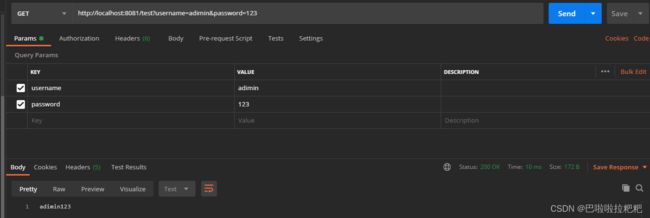SpringMVC获取请求参数的各种方法
1.使用注解@PathVariable,获取路径中的占位符
在RESTful风格API中,经常在路径中传递参数,比如路径localhost:8081/test/collection/1路径中最后的1代表id传递给后端
@RequestMapping("/test/collection/{id}")//如果少了参数会报404
public Integer testPathVariable(@PathVariable("id") Integer id){
System.out.println(id);
//最终在浏览器输出1
return id;
}
2.前端传递参数的两种格式
在这仅讨论GET、POST请求方式。总体将传递参数分为两种方式:
在GET请求中,通常在路径中使用?与&进行传参,如localhost:8081/test?user=adimin&password=123,然后在POST请求中与之对应也有一种请求头Content-Type:application/x-www-form-urlencoded,也会将请求参数通过?与&拼接在请求体中。
在POST请求中,还有另外一种请求头Content-Type:application/json,传递JSON字符串给后端,如{"username":"admin","password":"123456"}
3 请求头为application/x-www-form-urlencoded,SpinrgMVC获取参数的四种方式
以下四种方式对应的请求路径为:localhost:8081/test?user=adimin&password=123或使用POST请求以x-www-form-urlencoded方式发送请求体
3.1 使用HttpServletRequest
正如原生Servlet一样,SpringMVC也保留了HttpServletRequest,可以通过getParameter()获取参数
@GetMapping("/test")
public String testHttpServletRequest(HttpServletRequest request)
{
String username = request.getParameter("username");
String password = request.getParameter("password");
return username+password
}
3.2 使用同名参数(推荐)
@GetMapping("/test")
//参数名字必须相同
public String testHttpServletRequest(String username, String password)
{
return username+password
}
3.3 使用@RequestParam注解(推荐)
@GetMapping("/test")
//注解的value值对应传过来的参数名
public String testHttpServletRequest(@RequestParam("username")String name, @RequestParam("password")String password)
{
return name+password
}
3.4 使用实体类对象(推荐)
//实体类必须有参数名对应的属性,且属性get/set方法
@Data
public class User{
private String username;
private String password;
}
@GetMapping("/test")
public String testHttpServletRequest(User user)
{
return user.getName()+user.getPassword();
}
4.请求头为application/json
以下方法都是基于SpringMvc默认的Json数据解析器Jackson,使用ObjectMapper对象的readValue()方法进行解析
4.1 使用HttpServletRequest
@PostMapping("/test")
public String testRequestBody(HttpServletRequest request) throws IOException {
ObjectMapper objectMapper = new ObjectMapper();
User user = objectMapper.readValue(request.getInputStream(), User.class);
return user.getName()+user.getPassword();
}
4.2 使用@RequestBody注解,配合Map(推荐)
使用@RequestBody注解配合Map,Map中的key为传过来的参数名,值为对应的值
@PostMapping("/test")
public String testRequestBody(@RequestBody Map<String,String>map) throws IOException {
String username=map.get("username");
String password=map.get("password");
return username+password;
}
4.3使用@RequestBody注解,配合实体类(推荐)
@PostMapping("/test")
public String testRequestBody(@RequestBody User user){
return user.getName()+user.getPassword();
}
总结
无论是GET还是POST请求,主要分成两种传参方式:&与JSON字符串,具体由请求头决定。
&方式关注@RequestParam注解!!JSON字符串方式关注@RequestBody注解!!再配合形参/实体类对象/Map进行取值即可
